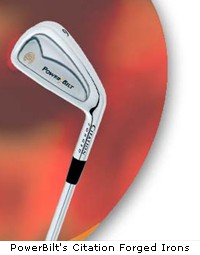|
PRODUCT REVIEW
|
|
The engineering
Mark Wilson, PowerBilt's Director of New Product Development said, "A major difference between the new Citations and other forged/hybrid irons is this: our top line thickness is only 0.185 of an inch. That's amazingly thin for a cavity back iron. When design savvy pros or players examine our irons, they'll also see that the top line flows into the hosel. That's important because it eliminates what golf club designers call 'bulkiness.' Bulkiness is a common, undesirable trait inherent in the design of other classic irons."
Mr. Wilson continued, "If you examine our competitors' top lines, you'll see they measure somewhere between 0.215-in. to 0.280-in. We believe that's too thick. Reason: because way too much weight/mass is wasted in an area that serves no functional purpose -- other than to make the center of gravity higher than it should be.
"As for our center of gravity, it is in the exact geometric center of the club face, which is exactly where it should be. I should add that the center of gravity is relatively low for a classic iron design, which was a key element in our 'evolutionary breakthrough.'"
How they play
The great thing about forged irons is that they can be so easily fitted to body-types and swings. We took our Citation Forged Irons -- bent to a lie-angle of two-degrees upright for yours truly -- to both the practice tee and two different courses. When we passed them around to a number of golfers, it was very consistently the lower handicap players who appreciated them best. Certain mid-handicappers, including yours truly, also loved the feel, as long as contact was made in the center of the club face.
Therein lies the rub with forged irons (even hybrid forged irons). When you hit the ball on the sweet spot, it feels like there's not even a ball there -- just a click and a perfectly shaped shot. When you miss, your fingers tingle, the clubhead thunks, and curses fly. With these relatively more forgiving forged irons, however, the ball still flies farther than the curses.
In short, for real players, there's nothing like forged irons. The nice thing about these Citation Forged Irons, is that the spiffy engineering does make them playable for mid-handicappers who simply can't get over the tawny lines of a classic blade.
Smoothing a purely struck forged Citation 3-iron into birdie range on a 215-yard par-3 is as sweet as getting a second chance from that sexy ex.
For more information, golfers can find the nearest PowerBilt outlet by calling (800) 848-7693 or by checking the PowerBilt Web site at powerbilt.com.
 PowerBilt Citation
PowerBilt Citation